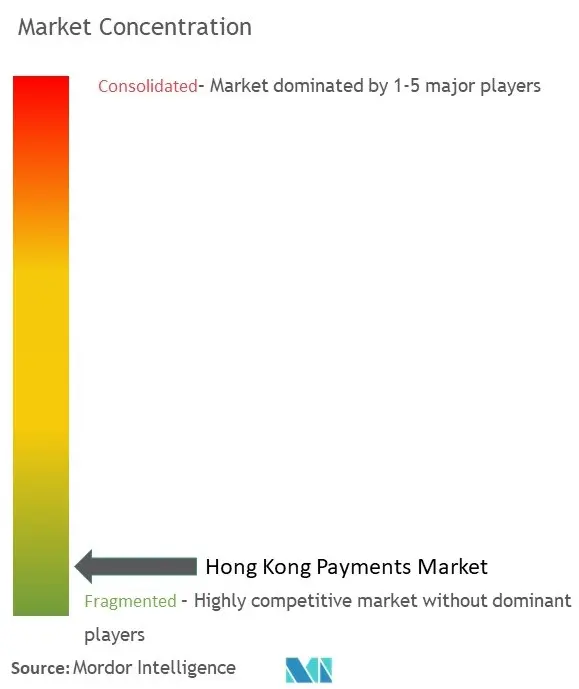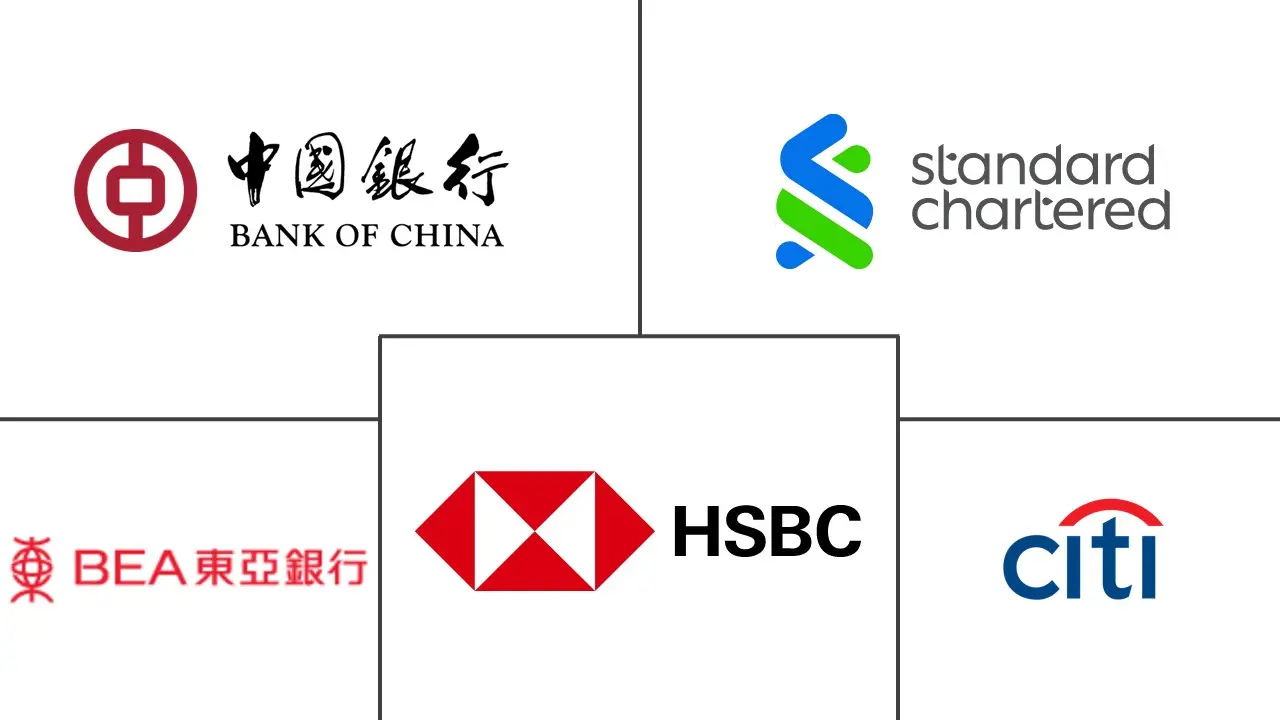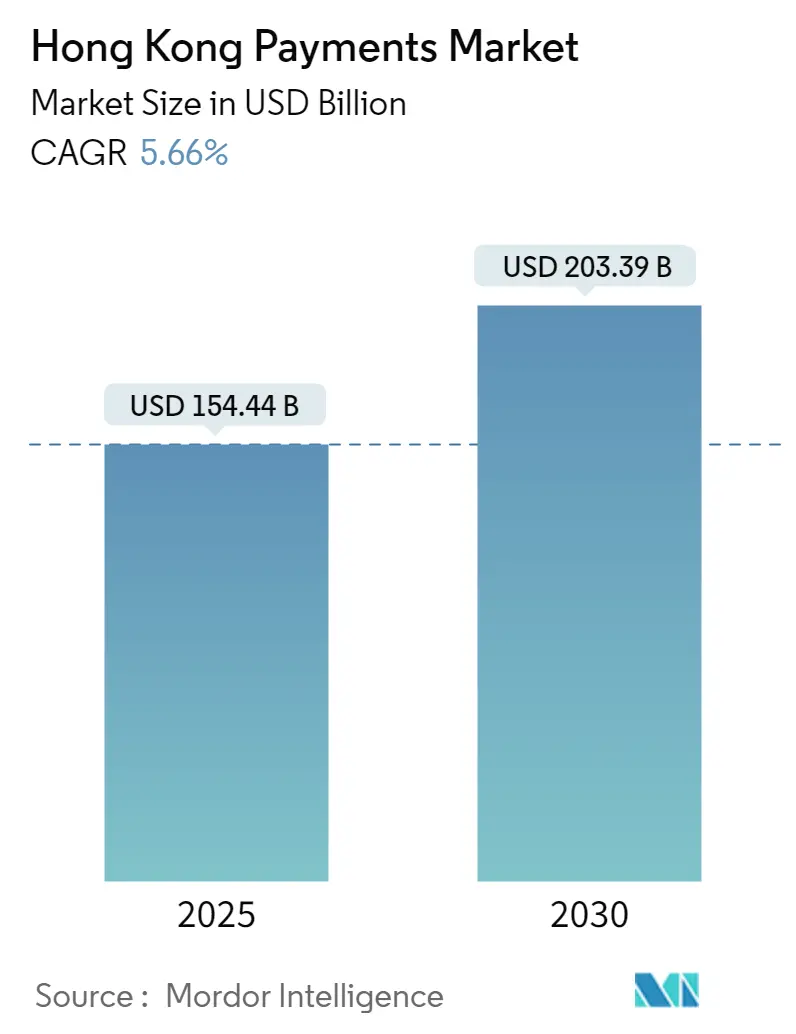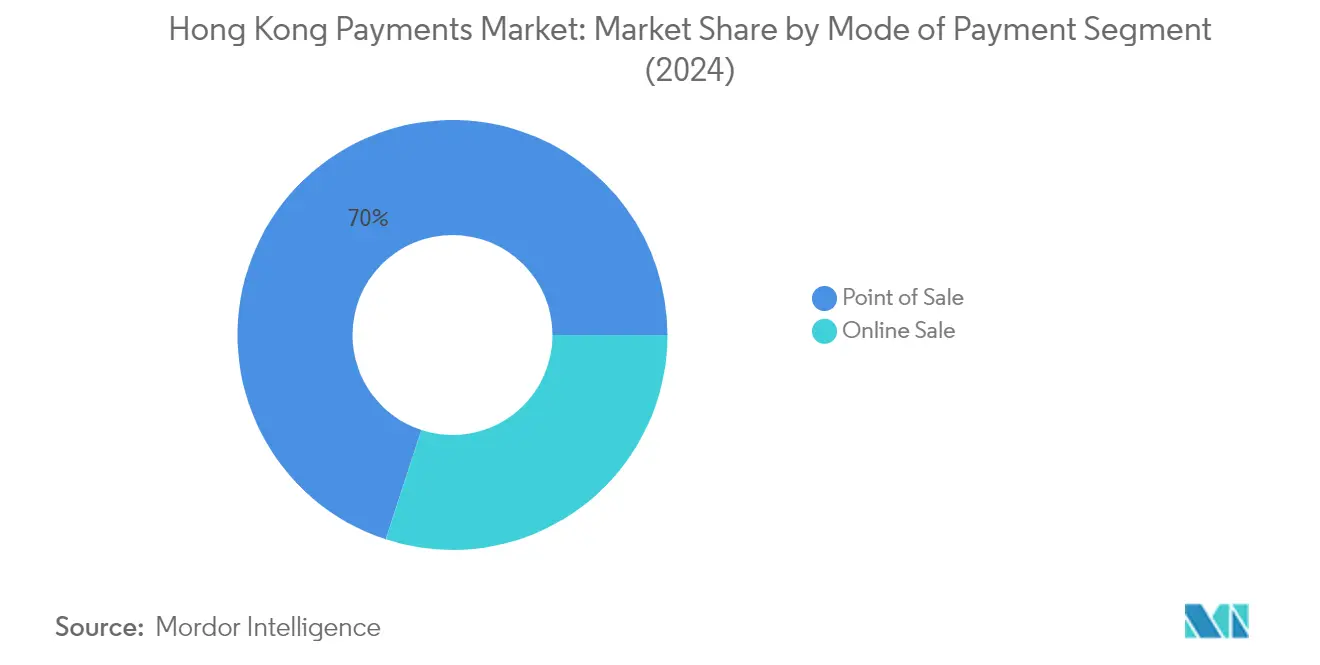Hong Kong Payment Market Analysis
The Hong Kong Payments Market size is estimated at USD 154.44 billion in 2025, and is expected to reach USD 203.39 billion by 2030, at a CAGR of 5.66% during the forecast period (2025-2030).
The Hong Kong payments landscape is undergoing a profound digital transformation, driven by changing consumer preferences and technological advancements. Credit cards remain a dominant payment method, with transaction volumes showing a 4.4% year-over-year increase by mid-2022, according to the Hong Kong Monetary Authority. The high penetration of banking services, with 95.3% of the population having bank accounts, has created a strong foundation for digital payment adoption. The market's evolution is further characterized by the emergence of multi-currency payment solutions, enabling seamless cross-border transactions with mainland China and reflecting Hong Kong's position as a global financial hub.
Consumer behavior in Hong Kong is rapidly shifting towards digital payments methods, with a notable preference for mobile payments and contactless payments solutions. According to a recent FIS report, digital wallets are projected to represent 40% of online payment value by 2025, surpassing credit cards as the preferred payment method. This transformation is evident in the retail sector, where major platforms have experienced significant user growth, with over 4.7 million new consumers adopting digital payment platforms in 2021. The integration of various payment options has become crucial for businesses, as one in three customers may abandon purchases if their preferred digital payment method is not available.
The payment infrastructure in Hong Kong continues to evolve with innovative solutions and partnerships. In 2023, significant developments included the integration of Pine Labs' Buy Now Pay Later (BNPL) services across six major Asian markets, including Hong Kong, and the launch of Ant Bank PayLater on AlipayHK. These developments have enhanced the payment ecosystem's sophistication, offering consumers greater flexibility and convenience in their financial transactions. The market has also witnessed the emergence of specialized solutions for different sectors, from retail to transportation, with taxi services now equipped with contactless payment capabilities.
The cross-border payments landscape is experiencing significant transformation with the introduction of new technologies and platforms. The implementation of the digital yuan (e-CNY) initiatives in 2023 marks a significant step in Hong Kong's role as a bridge between mainland China and international markets. Financial institutions are actively developing infrastructure to support cross-border transactions, with major banks offering unique Greater Bay Area (GBA) cards and specialized e-wallet solutions for cross-border payments. This evolution is particularly significant given Hong Kong's strategic position as a financial center, with banks increasingly offering integrated solutions that combine traditional banking services with innovative payment technologies.
Hong Kong Payment Market Trends
Integration of Payment Gateways
Hong Kong's payment landscape is experiencing rapid transformation through the sophisticated integration of payment gateways, supported by the region's robust payment infrastructure and a high banking penetration rate of 95.3%. Payment service providers are implementing comprehensive solutions that enable merchants to accept multiple payment methods through a single integrated platform, including credit transfers, direct debits, and real-time bank transactions. The integration of payment gateways has been particularly enhanced by domestic banks offering multi-currency cards that facilitate payments in various currencies, capitalizing on Hong Kong's unique position as a gateway for cross-border spending with mainland China.
The payment gateway integration has evolved to incorporate innovative solutions such as UnionPay International's Mobile Phone as POS (MPP) solution, which enables smartphones to function as POS terminals for small businesses without requiring extensive technical modifications. These integrated payment solutions support various payment methods, including card/phone tap and QR codes, making transactions more accessible and efficient for both merchants and consumers. Furthermore, payment gateway providers are focusing on developing omnichannel solutions that seamlessly connect online and offline payment experiences, allowing businesses to manage transactions across multiple channels through a single integrated platform while ensuring high payment security standards and regulatory compliance.
Initiatives by the Government to Advance in Digital Payments
The Hong Kong Monetary Authority (HKMA) has implemented several strategic initiatives to accelerate the adoption of digital payments, including the Faster Payment System (FPS) and the Common Quick Response Code Specification for retail payments. These initiatives have shown significant impact, with credit card transactions reaching 242.79 million by mid-2022, marking a 4.4% increase from the previous year. The government's commitment to digital payment advancement is further demonstrated through the Central Bank Digital Currency (CBDC) track addition to the Global Fast Track 2022, which encourages innovation in areas such as programmable money, retail and wholesale CBDC adoption, interoperability, and cybersecurity.
The government's progressive approach is also evident in its collaboration with financial institutions to promote new payment technologies. For instance, the Bank of China (Hong Kong) has taken the initiative to encourage digital yuan (e-CNY) adoption by offering incentives such as red packet rewards worth 100 e-CNY for consumer registration. Additionally, the Hong Kong Special Administrative Region Government has introduced the Government Green Bond Programme, demonstrating its commitment to sustainable finance and digital payment innovation. These initiatives are complemented by the implementation of the Payment Cards Framework, which helps merchants better manage their payment card acceptance costs and addresses frictions in the payment ecosystem to foster increased usage of digital payment methods.
Segment Analysis: By Mode of Payment
Point of Sale (POS) Segment in Hong Kong Payments Market
The Point of Sale (POS) segment continues to dominate the Hong Kong payments market, commanding approximately 70% of the total market share in 2024. This segment encompasses various POS payment methods, including card payments, digital wallets, cash transactions, and other point-of-sale solutions. The strong performance of this segment is driven by the widespread adoption of contactless payment technologies across retail establishments, the growing infrastructure of POS terminals, and increasing consumer preference for convenient payment options at physical locations. The segment's robustness is further reinforced by the Hong Kong Monetary Authority's initiatives to modernize payment infrastructure and the increasing integration of innovative payment solutions by merchants. Major financial institutions and payment service providers are continuously enhancing their POS offerings with features like instant payments, multi-currency support, and enhanced security measures to maintain their market position.
Online Sale Segment in Hong Kong Payments Market
The Online Sale segment is emerging as the most dynamic sector in the Hong Kong payments market, demonstrating remarkable growth potential with an expected CAGR of approximately 14% during the forecast period 2024-2029. This impressive growth trajectory is being fueled by the rapid expansion of e-commerce platforms, increasing consumer confidence in online payments, and the proliferation of mobile shopping applications. The segment is witnessing significant innovations in payment processing technologies, including the integration of advanced security features, seamless checkout processes, and the adoption of various digital payment methods. The growth is further accelerated by the rising popularity of mobile payments, the implementation of real-time payment systems, and the increasing preference for electronic payment solutions. Financial institutions and technology companies are actively investing in developing robust online payment infrastructure, while regulatory bodies are creating supportive frameworks to ensure secure and efficient digital transactions.
Segment Analysis: By End-User Industry
Retail Segment in Hong Kong Payments Market
The retail segment dominates the Hong Kong payments market, commanding approximately 40% of the total market share in 2024, while also maintaining the highest growth trajectory in the industry. This segment's prominence is driven by the rapid evolution of digital payment technologies and changing consumer preferences in Hong Kong's retail landscape. The increasing adoption of payment solutions across physical and online retail stores, coupled with the Hong Kong Monetary Authority's initiatives to promote cashless transactions, has significantly contributed to this segment's growth. Major retail chains and small merchants alike are increasingly integrating various payment options, including mobile payments, contactless payments, and QR code-based solutions, to enhance customer experience and operational efficiency. The segment's growth is further supported by the robust e-commerce ecosystem and the increasing preference for online payments among Hong Kong consumers for their daily retail transactions.
Remaining Segments in Hong Kong Payments Market
The healthcare segment represents a significant portion of the payments market, driven by the increasing digitization of healthcare services and the integration of digital payment solutions in hospitals and clinics. The entertainment sector has shown substantial growth through the adoption of digital payments for streaming services, gaming, and other entertainment platforms. The hospitality segment continues to evolve with the implementation of contactless payment solutions and digital wallets in hotels, restaurants, and tourism services. Other end-user industries, including BFSI, telecommunications, and education, collectively form a substantial portion of the market, each contributing to the diverse payment ecosystem through specialized payment solutions and innovative financial technologies that cater to their unique requirements and customer needs.
Hong Kong Payment Industry Overview
Top Companies in Hong Kong Payments Market
The Hong Kong payments market is dominated by established financial institutions and payment technology providers, including HSBC, Bank of China, Bank of East Asia, Standard Chartered Bank, Citibank, EPS Company, Visa, Mastercard, American Express, and Diners Club International. These companies are actively pursuing digital transformation initiatives, with significant investments in mobile payment solutions, contactless technologies, and integrated payment platforms. The industry demonstrates strong innovation trends through the development of virtual card solutions, digital wallets, and real-time payment systems. Companies are forming strategic partnerships with fintech firms and technology providers to enhance their service offerings and maintain competitive advantage. Market leaders are expanding their digital payment infrastructure while simultaneously maintaining traditional payment channels to serve diverse customer segments. Operational agility is evidenced through rapid adoption of new technologies like blockchain, AI-powered fraud detection, and enhanced payment security protocols, while strategic expansion focuses on cross-border payment capabilities and integration with regional payment networks.
Dynamic Market with Strong Local Players
The Hong Kong payments market exhibits a balanced mix of global financial institutions and local banking powerhouses, creating a competitive environment that drives innovation and service quality. Traditional banks maintain significant market share through their established networks and trusted relationships, while global payment technology providers bring international expertise and advanced solutions. The market structure shows moderate consolidation, with major players holding substantial market share while leaving room for innovative fintech entrants and specialized payment service providers. Strategic partnerships and collaborations between established players and emerging fintech companies are increasingly common, creating an ecosystem that combines traditional financial strength with technological innovation.
The market demonstrates strong interconnectivity between local and international payment systems, facilitated by Hong Kong's position as a global financial hub. Market participants are actively engaged in strategic alliances and partnerships rather than traditional mergers and acquisitions, focusing on capability enhancement and market reach expansion. The competitive landscape is characterized by continuous investment in digital payment infrastructure, customer experience enhancement, and development of innovative payment solutions. Local players leverage their deep understanding of regional market dynamics and regulatory requirements, while global players bring international best practices and technological advancement to the market.
Innovation and Customer Experience Drive Success
Success in the Hong Kong payments market increasingly depends on the ability to deliver seamless, secure, and innovative payment solutions while maintaining regulatory compliance and operational efficiency. Incumbent players must focus on continuous technological innovation, enhanced cybersecurity measures, and improved customer experience to maintain their market position. The development of comprehensive digital payment ecosystems, integration with emerging technologies, and strategic partnerships with fintech companies are becoming crucial for market success. Companies must also balance innovation with risk management, ensuring robust security measures while delivering convenient payment solutions.
Market contenders can gain ground by focusing on specialized market segments, developing unique value propositions, and leveraging technological advantages to address specific customer needs. Success factors include the ability to adapt to changing regulatory requirements, particularly in areas of data protection and cross-border payments. The market shows moderate end-user concentration, with retail and corporate segments driving significant financial transaction volumes. While substitution risk from alternative payment methods exists, established players can mitigate this through continuous innovation and service enhancement. Regulatory support for digital payment initiatives creates opportunities for both incumbents and new entrants, while maintaining strict compliance requirements that influence market dynamics.
Hong Kong Payment Market Leaders
-
HSBC
-
Bank of China
-
The Bank of East Asia Limited (BEA)
-
Standard Chartered Bank (HK) Limited
-
Citibank
- *Disclaimer: Major Players sorted in no particular order

Hong Kong Payment Market News
- November 2023 - JCB and Stripe Expanded their Partnership to Europe, Singapore, and Hong Kong. As part of this expansion, Stripe added JCB to its default payment scheme for merchants in the United Kingdom and Ireland in August and for merchants in other European countries, Singapore and Hong Kong.
Hong Kong Payment Market Report - Table of Contents
1. INTRODUCTION
- 1.1 Study Assumptions and Market Definition
- 1.2 Scope of the Study
2. RESEARCH METHODOLOGY
3. EXECUTIVE SUMMARY
4. MARKET INSIGHTS
- 4.1 Market Overview
- 4.2 Industry Stakeholder Analysis
-
4.3 Industry Attractiveness - Porter's Five Forces Analysis
- 4.3.1 Bargaining Power of Suppliers
- 4.3.2 Bargaining Power of Buyers
- 4.3.3 Threat of New Entrants
- 4.3.4 Threat of Substitutes
- 4.3.5 Intensity of Competitive Rivalry
- 4.4 Evolution of the Payments Landscape in the Country
- 4.5 Key Market Trends Pertaining to the Growth of Cashless Transactions in the Country
- 4.6 Impact of COVID-19 on the Payments Market in the Country
5. MARKET DYNAMICS
-
5.1 Market Drivers
- 5.1.1 Integration of Payment Gateways
- 5.1.2 Initiatives by the Government to Advance in Digital Payments
-
5.2 Market Challenges
- 5.2.1 Lack of a Standard Legislative Policy Remains Especially in the Case of Cross-border Transactions
-
5.3 Market Opportunities
- 5.3.1 Move towards Cashless Society
- 5.3.2 New Entrants to Drive Innovation Leading to Higher Adoption
- 5.4 Key Regulations and Standard in the Digital Payments Industry
- 5.5 Analysis of Major Case Studies and Use-cases
- 5.6 Analysis of Key Demographic Trends and Patterns Related to the Payments Industry in Hong Kong
- 5.7 Analysis of the Increasing Emphasis on Customer Satisfaction and Convergence of the Global Trends in Hong Kong
- 5.8 Analysis of Cash Displacement and Rise of Contactless Payment Modes in Hong Kong
6. MARKET SEGMENTATION
-
6.1 By Mode of Payment
- 6.1.1 By Point of Sale
- 6.1.1.1 Card Payments
- 6.1.1.2 Digital Wallet
- 6.1.1.3 Cash
- 6.1.1.4 Other Point of Sales
- 6.1.2 By Online Sale
- 6.1.2.1 Card Payments
- 6.1.2.2 Digital Wallet
- 6.1.2.3 Other Online Sales
-
6.2 By End-user Industry
- 6.2.1 Retail
- 6.2.2 Entertainment
- 6.2.3 Healthcare
- 6.2.4 Hospitality
- 6.2.5 Other End-user Industries
7. COMPETITIVE LANDSCAPE
-
7.1 Company Profiles*
- 7.1.1 HSBC
- 7.1.2 Bank of China
- 7.1.3 The Bank of East Asia Limited (BEA)
- 7.1.4 Standard Chartered Bank (HK) Limited
- 7.1.5 Citibank
- 7.1.6 EPS Company
- 7.1.7 Visa Inc.
- 7.1.8 Mastercard Incorporated
- 7.1.9 American Express Company
- 7.1.10 Diners Club International
8. INVESTMENT ANALYSIS
9. FUTURE OF THE MARKET
Hong Kong Payment Industry Segmentation
The point of sale is the time and location where a transaction is completed. A point-of-sale (POS) system is a combination of computer hardware and software that manages transactions during the sale of a product or service. It helps to store, capture, share, and report data related to sales transactions. It eases the shopping experience and helps expedite the checkout process, resulting in customer satisfaction. Inventory management, stock in hand, availability of a product, and pricing information are the primary data acquired from the systems.
The Hong Kong Payment Market is segmented by mode of payment (point of sale (card payments, digital wallet, cash), online sale (card payments, digital wallet)) by end-user industry (retail, entertainment, healthcare, hospitality). The market sizes and forecasts are provided in terms of value in USD for all the above segments.
| By Mode of Payment | By Point of Sale | Card Payments | |
| Digital Wallet | |||
| Cash | |||
| Other Point of Sales | |||
| By Online Sale | Card Payments | ||
| Digital Wallet | |||
| Other Online Sales | |||
| By End-user Industry | Retail | ||
| Entertainment | |||
| Healthcare | |||
| Hospitality | |||
| Other End-user Industries | |||
Hong Kong Payment Market Research FAQs
How big is the Hong Kong Payments Market?
The Hong Kong Payments Market size is expected to reach USD 154.44 billion in 2025 and grow at a CAGR of 5.66% to reach USD 203.39 billion by 2030.
What is the current Hong Kong Payments Market size?
In 2025, the Hong Kong Payments Market size is expected to reach USD 154.44 billion.
Who are the key players in Hong Kong Payments Market?
HSBC, Bank of China, The Bank of East Asia Limited (BEA), Standard Chartered Bank (HK) Limited and Citibank are the major companies operating in the Hong Kong Payments Market.
What years does this Hong Kong Payments Market cover, and what was the market size in 2024?
In 2024, the Hong Kong Payments Market size was estimated at USD 145.70 billion. The report covers the Hong Kong Payments Market historical market size for years: 2019, 2020, 2021, 2022, 2023 and 2024. The report also forecasts the Hong Kong Payments Market size for years: 2025, 2026, 2027, 2028, 2029 and 2030.
Our Best Selling Reports
Hong Kong Payments Market Research
Mordor Intelligence provides a comprehensive analysis of the Hong Kong payments landscape. We leverage our extensive expertise in payment technology and financial transaction research. Our detailed report examines the evolution of electronic payments, the adoption of digital wallets, and the implementation of payment gateways across the region. The analysis covers various payment channels, including online payments, mobile payments, and contactless payments. It also addresses emerging trends in cryptocurrency payments and alternative payments. Our research methodology incorporates a detailed assessment of payment infrastructure developments and payment processing systems. This information is available in an easy-to-download report PDF.
The report provides stakeholders with actionable insights into payment solutions across multiple segments. These segments include B2B payments, P2P payments, and C2B payments. We thoroughly examine payment security measures and payment authentication protocols, which are essential for modern digital payments systems. The analysis covers instant payments, POS payments, and wholesale payments infrastructure. It offers valuable insights for businesses implementing merchant payment solutions. Stakeholders benefit from our detailed examination of unified payments systems and money transfer mechanisms. This is supported by a comprehensive payment services analysis and emerging retail payments trends, all presented in an accessible report PDF format.





